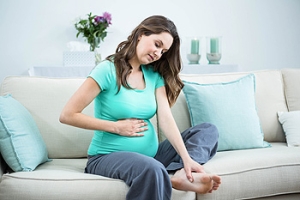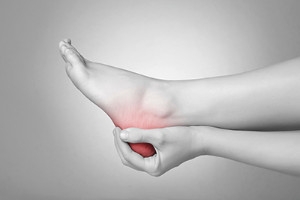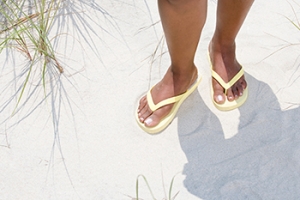Connect With Us
Blog

Diagnosing Stress Fractures
 A stress fracture is a tiny crack in a bone that often occur in the feet as a result of overuse while playing sports or doing activities that involve running or jumping. Everyday activities can also lead to stress fractures in people with weakened bones. Pain, tenderness, and swelling are usually the first indications of a stress fracture. These symptoms should not be ignored, as stress fractures may worsen over time if left untreated. A podiatrist can diagnose a stress fracture by taking a thorough medical history, completing a physical examination, and ordering imaging studies such as X-rays or bone scans. If you suspect that you may have a stress fracture in your foot or ankle, please see a podiatrist.
A stress fracture is a tiny crack in a bone that often occur in the feet as a result of overuse while playing sports or doing activities that involve running or jumping. Everyday activities can also lead to stress fractures in people with weakened bones. Pain, tenderness, and swelling are usually the first indications of a stress fracture. These symptoms should not be ignored, as stress fractures may worsen over time if left untreated. A podiatrist can diagnose a stress fracture by taking a thorough medical history, completing a physical examination, and ordering imaging studies such as X-rays or bone scans. If you suspect that you may have a stress fracture in your foot or ankle, please see a podiatrist.
Activities where too much pressure is put on the feet can cause stress fractures. To learn more, contact one of our podiatrists from Family Foot Care of Long Island. Our doctors can provide the care you need to keep your pain free and on your feet.
Dealing with Stress Fractures of the Foot and Ankle
Stress fractures occur in the foot and ankle when muscles in these areas weaken from too much or too little use. The feet and ankles then lose support when walking or running from the impact of the ground. Since there is no protection, the bones receive the full impact of each step. Stress on the feet can cause cracks to form in the bones, thus creating stress fractures.
What Are Stress Fractures?
Stress fractures occur frequently in individuals whose daily activities cause great impact on the feet and ankles. Stress factors are most common among:
- Runners
- People affected with Osteoporosis
- Tennis or basketball players
- Gymnasts
- High impact workouts
Symptoms
Pain from the fractures occur in the area of the fractures and can be constant or intermittent. It will often cause sharp or dull pain with swelling and tenderness. Engaging in any kind of activity which involves high impact will aggravate pain.
If you have any questions please feel free to contact our office located in Port Jefferson Station, NY . We offer the newest diagnostic and treatment technologies for all your foot and ankle needs.
Stress Fractures of the Foot and Ankle
Our bones are important aspects of our body and they are constantly changing. The heavier the workload for a bone, the more likely it is that calcium will be placed in it. When a bone isn’t used often, there won’t be much calcium within it. When stress from repetitive loads prevent the bone from being able to repair itself, cracks will start to form. Stress fractures are defined as cracks in a bone that result from repetitive force, such as overuse.
The most common cause of stress fractures is a sudden increase in intensity and duration of physical activity. For example, if you begin to run long distances without working your way into doing so, you will be more likely to develop a stress fracture.
Common symptoms of stress fractures are pain and swelling near the weight bearing area on the injured bone. When initial x-rays are performed, it is possible that the fracture will not show up. However, once the stress on the area continues, the damage will increase, and the fracture will be severe enough to show up on an x-ray. Certain parts of the foot are more likely to develop stress fractures than others. Areas that typically have these fractures are: the metatarsals, the navicular bone, the calcaneus, tibia, and fibula.
Since women are at an increased risk of developing osteoporosis, they are twice as likely as men to sustain a stress fracture. Additionally, old age causes a decrease in bone mineral density which is why elderly people are also likely to develop these fractures.
It is important for you to be professionally diagnosed by a podiatrist if you suspect you have a stress fracture, because there are other injuries that can easily be mistaken for a fracture. Sprains, strains, shin splints, plantar fasciitis, and Morton’s neuroma can all easily be mistaken for stress fractures in the foot. Your podiatrist will likely ask you a series of questions to determine what type of pain you are experiencing. These questions will help your doctor identify whether you have a stress fracture.
The best method of treatment for a stress fracture is rest. Additionally, a walking boot, cast, or crutches, will help rest the area that is injured. The typical healing time for stress fractures is 4-12 weeks, however this depends on which bone is involved.
Why Feet Swell During Pregnancy
 Swelling in the feet and legs during pregnancy is very common, and it usually worsens towards the end of the day and further into the pregnancy. The swelling is the result of the body holding more water than usual, and the water pools up at the lower parts of the body. This swelling is not usually harmful, but it can get uncomfortable. However, a sudden increase of swelling can be a sign of pre-eclampsia and should be monitored as soon as possible. Common methods to reduce lower limb swelling include avoiding standing for long periods, wearing comfortable shoes and socks that aren’t too tight, resting with the feet up, and taking regular walks. If you are struggling with swollen feet during your pregnancy, a podiatrist will be able to help provide ways to manage the situation.
Swelling in the feet and legs during pregnancy is very common, and it usually worsens towards the end of the day and further into the pregnancy. The swelling is the result of the body holding more water than usual, and the water pools up at the lower parts of the body. This swelling is not usually harmful, but it can get uncomfortable. However, a sudden increase of swelling can be a sign of pre-eclampsia and should be monitored as soon as possible. Common methods to reduce lower limb swelling include avoiding standing for long periods, wearing comfortable shoes and socks that aren’t too tight, resting with the feet up, and taking regular walks. If you are struggling with swollen feet during your pregnancy, a podiatrist will be able to help provide ways to manage the situation.
Pregnant women with swollen feet can be treated with a variety of different methods that are readily available. For more information about other cures for swollen feet during pregnancy, consult with one of our podiatrists from Family Foot Care of Long Island. Our doctors will attend to all of your foot and ankle needs.
What Foot Problems Can Arise During Pregnancy?
One problem that can occur is overpronation, which occurs when the arch of the foot flattens and tends to roll inward. This can cause pain and discomfort in your heels while you’re walking or even just standing up, trying to support your baby.
Another problem is edema, or swelling in the extremities. This often affects the feet during pregnancy but tends to occur in the later stages.
How Can I Keep My Feet Healthy During Pregnancy?
- Wearing orthotics can provide extra support for the feet and help distribute weight evenly
- Minimize the amount of time spent walking barefoot
- Wear shoes with good arch support
- Wear shoes that allow for good circulation to the feet
- Elevate feet if you experience swelling
- Massage your feet
- Get regular, light exercise, such as walking, to promote blood circulation to the feet
If you have any questions please feel free to contact our office located in Port Jefferson Station, NY . We offer the newest diagnostic and treatment technologies for all your foot and ankle needs.
Pregnancy and Foot Health
Many pregnant women complain about foot pain while they are expecting. Foot pain can primarily be caused by weight gain and hormonal changes taking place in the body. By understanding how pregnancy impacts the health of a woman's feet, a pregnant woman can take action to keep her feet as healthy and comfortable as possible.
Because a woman's weight changes during pregnancy, more pressure is brought to bear on both the legs and the feet. This weight shift can cause two major foot problems: over-pronation, also known as flat feet, as well as edema, which is swelling of the feet. Over-pronation occurs when the arch of the foot flattens, causing the foot to roll inwards when the individual is walking, and can aggravate the plantar fascia tissues located along the bottom of the feet. If these tissues become inflamed, a pregnant woman can experience pain in the heel of the foot as well as severe foot pain while walking or standing. Swelling of the feet, or edema, often occurs in the later stages of pregnancy. It is caused by slow circulation and water retention, and may turn the feet a light purple color.
To keep feet in good health and prevent over-pronation, pregnant women should avoid walking barefoot and be sure they are wearing shoes that offer good arch support. A device known as an orthotic can be added to regular footwear in order to provide additional support for the feet during pregnancy. Any expectant mother whose feet hurt should first check to see if the shoes she is wearing are old, worn out and not offering the proper support necessary for distributing the weight of her body during pregnancy.
To treat edema of the feet, a good start is to wear quality footwear which offers support and good circulation. Keep feet elevated whenever possible by using a foot stool while seated. Stay well hydrated by drinking plenty of water to prevent water retention in the feet. Any swelling that occurs in only one foot should be examined as soon as possible by a doctor.
Good foot health during pregnancy can help expectant mothers avoid foot pain that leads to other health problems. Massaging the feet and doing regular gentle exercise like walking aids foot health by contributing to good circulation. Supportive shoes are also a good investment that will support foot health during pregnancy.
Types of Heel Pain a Podiatrist Can Treat
 Heel pain can develop due to a variety of sources or causes, and can impact everyday life. The most common cause of heel pain is plantar fasciitis which occurs when the plantar fascia (the tissue that runs along the bottom of the foot connecting the heel to the toes) becomes inflamed. Heel spurs are another way heel pain may occur. This condition may occur when there is an abnormal bone growth where the plantar fascia and heel bone attach. Other painful heel conditions include calcaneal apophysitis (where the heel bone is irritated from new shoes or athletic activity), bursitis (inflammation of the sac that lines many joints), or a trapped nerve (when the nerves become compressed). Patients who are struggling with heel pain should consult with a podiatrist. A podiatrist will assess details regarding your pain, medical history and lifestyle. A podiatrist will also examine your gait, feet, and nerves to diagnose the source of heel pain and provide the best treatment.
Heel pain can develop due to a variety of sources or causes, and can impact everyday life. The most common cause of heel pain is plantar fasciitis which occurs when the plantar fascia (the tissue that runs along the bottom of the foot connecting the heel to the toes) becomes inflamed. Heel spurs are another way heel pain may occur. This condition may occur when there is an abnormal bone growth where the plantar fascia and heel bone attach. Other painful heel conditions include calcaneal apophysitis (where the heel bone is irritated from new shoes or athletic activity), bursitis (inflammation of the sac that lines many joints), or a trapped nerve (when the nerves become compressed). Patients who are struggling with heel pain should consult with a podiatrist. A podiatrist will assess details regarding your pain, medical history and lifestyle. A podiatrist will also examine your gait, feet, and nerves to diagnose the source of heel pain and provide the best treatment.
Many people suffer from bouts of heel pain. For more information, contact one of our podiatrists of Family Foot Care of Long Island. Our doctors can provide the care you need to keep you pain-free and on your feet.
Causes of Heel Pain
Heel pain is often associated with plantar fasciitis. The plantar fascia is a band of tissues that extends along the bottom of the foot. A rip or tear in this ligament can cause inflammation of the tissue.
Achilles tendonitis is another cause of heel pain. Inflammation of the Achilles tendon will cause pain from fractures and muscle tearing. Lack of flexibility is also another symptom.
Heel spurs are another cause of pain. When the tissues of the plantar fascia undergo a great deal of stress, it can lead to ligament separation from the heel bone, causing heel spurs.
Why Might Heel Pain Occur?
- Wearing ill-fitting shoes
- Wearing non-supportive shoes
- Weight change
- Excessive running
Treatments
Heel pain should be treated as soon as possible for immediate results. Keeping your feet in a stress-free environment will help. If you suffer from Achilles tendonitis or plantar fasciitis, applying ice will reduce the swelling. Stretching before an exercise like running will help the muscles. Using all these tips will help make heel pain a condition of the past.
If you have any questions please contact our office located in Port Jefferson Station, NY . We offer the newest diagnostic and treatment technologies for all your foot and ankle needs.
Heel Pain
Heel pain can be difficult to deal with, especially if you do not know what the underlying cause is. If you ignore your heel pain, the pain can magnify and potentially develop into a chronic condition. Depending on the location of your heel pain, you have developed a specific condition.
One condition is plantar fasciitis. Plantar fasciitis is caused by the inflammation of the plantar fascia, or the band of tissue that connects the heel bone to the base of the toes. The pain from this condition is initially mild but can intensify as more steps are taken when you wake up in the morning. To treat this condition, medication will likely be necessary. Plantar fasciitis is often associated with heel spurs; both require rest and special stretching exercises.
There are various options your podiatrist may suggest for heel pain. Treatment options for heel pain typically include non-steroidal anti-inflammatory drugs (NSAIDS), which may reduce swelling and pain. Other options are physical therapy, athletic taping, and orthotics. In severe cases of heel pain, surgery may be required.
Preventing heel pain is possible. If you are looking to prevent heel pain from developing in the future, be sure to wear shoes that fit you properly and do not have worn down heels or soles. Be sure to warm up properly before participating in strenuous activities or sports that place a lot of a stress on the heels. If you are experiencing any form of heel pain, speak with your podiatrist to determine the underlying cause and receive the treatment you need.
Flip-Flops and Foot Problems
After a long winter, the sun is shining, the weather is warm, and you can finally wear your favorite flip-flops every day. Or, maybe not. Flip-flops, while relatively comfortable and easy to slip on, are not good for your feet. When you wear flip-flops, you may notice that you have to clench your toes around the edge of the shoe to keep it in place as you walk. This action is bad for the muscles in your feet and calves. The constant tension in your toes needed to keep that flip-flop on your foot can change your pattern of walking, make the toes stiff, and lead to foot and ankle injuries. Frequent flip-flop wearers may be more at risk of plantar fasciitis, a condition that causes stabbing heel pain and makes walking uncomfortable. Instead of flip-flops, try sandals that have a back and straps to keep your foot in place. If you have any foot or ankle pain, please consult with a podiatrist.
Flip-flops are not always the best choice of footwear. If you have any concerns about your feet or ankles, contact one of our podiatrists from Family Foot Care of Long Island. Our doctors will assist you with all of your foot and ankle needs.
Flip-Flops and Feet
When the weather starts warming up, people enjoy wearing flip-flops. Flip-flops are comfortable, stylish, and easy to slip on and off; they're perfect for any summer beach goer. However, these shoes can cause harm to the feet.
How Can Flip-Flops Affect Me Long-Term?
- Ankle problems
- Hip problems
- Lower back problems
- Pain in the balls of the feet
- Problems with foot arches
- Changes in the way you walk
Are There Injuries Associated with Flip-Flops?
Yes. Since flip-flops are relatively weak and do not provide the same amount of support as sneakers, people who wear flip-flops regularly are more susceptible to injuries. On top of that, the open nature of the shoe makes your feet more prone to other problems, such as cuts and even infections. Common injuries and ailments include:
- Sprained ankles
- Blisters
- Infections
- Cuts and Scrapes
I like Wearing Flip-Flops. Are There Safe Alternatives?
When buying flip-flops, try to find ones that have sturdy soles and that are made of high-quality materials that will support for your feet. These flip-flops will cost more but will also last longer as a result.
If you have any questions please feel free to contact our office located in Port Jefferson Station, NY . We offer the newest diagnostic and treatment technologies for all your foot and ankle needs.
Flip Flops and Feet
Flip flops are often a popular choice of footwear for many people. Flip flops allow your feet to breathe and give your toes the freedom of movement. They are easy to slip on and can be worn with virtually any style of clothing. Flip flops, however, despite their many benefits, can be detrimental for your foot health.
Despite their comfortableness, frequently wearing flip flops can create problems in the lower body over time. Issues mainly stem from the fact that people walk differently in flip flops compared to other footwear, such as sneakers. This is due to a change in one’s natural gait, which therefore creates stress in different parts of the body while hindering the body’s natural posture. Problems can also arise in the arches and balls of the feet. Flip flops provide little to no support to these areas.
Aside from long-term problems, flip-fops can also create short-term issues as well, such as ankle sprains and blisters. Weak materials that are flexible and bendable are generally used to manufacture flip flops. These materials make its wearers prone to both tripping and injuring their ankles. Flip flops can create blisters as the material rubs against the foot. People are much more at risk for infection while wearing flip flops due to their openness. This also makes it easier to scrape and cut the foot since there is a lack of protection. If these cuts are left untreated and uncovered, the risk then becomes greater.
To prevent the aforementioned occurrences, purchase a pair of flip flops that offer significant protection. The soles of the flip flops should not be floppy, but sturdy and firm, and should not significantly bend or wiggle when lifted from the floor. Flip flops made of high-quality materials will not be affected by this problem. While higher quality flip flops may be more expensive, they will last longer and provide better protection compared to a cheaper pair. Brand name flip flops sold from a quality manufacturer are a dependable option.
There is no problem in wearing your favorite pair of flip flops so as long as you do not wear them daily or for extended periods of time. Flip flops should be replaced every 3-4 months to ensure that they provide your feet with the best protection.
Wounds That Don't Heal Need to Be Checked
Preventing Falls in Children
 Falls are a leading cause of injury for not just older adults, but also for children. In fact, falls are the leading cause of injury in children from birth to about 19 years of age. Falls can result in a variety of foot and ankle injuries, from sprains to fractures and beyond. Fortunately, there are steps you can take to prevent your child from falling and incurring a serious injury. If your child plays on a playground, check the surface under the playground to ensure that it is soft and safe, as well as supervise your child while they play. Make your home safer by using stair gates and guard rails to prevent your child from falling down the stairs. If your child participates in sports, make sure that they wear helmets, padding, or any other safety gear that the sport requires. If your child falls and injures their feet or ankles, take them to see a podiatrist who can diagnose and treat their condition.
Falls are a leading cause of injury for not just older adults, but also for children. In fact, falls are the leading cause of injury in children from birth to about 19 years of age. Falls can result in a variety of foot and ankle injuries, from sprains to fractures and beyond. Fortunately, there are steps you can take to prevent your child from falling and incurring a serious injury. If your child plays on a playground, check the surface under the playground to ensure that it is soft and safe, as well as supervise your child while they play. Make your home safer by using stair gates and guard rails to prevent your child from falling down the stairs. If your child participates in sports, make sure that they wear helmets, padding, or any other safety gear that the sport requires. If your child falls and injures their feet or ankles, take them to see a podiatrist who can diagnose and treat their condition.
Preventing falls among the elderly is very important. If you are older and have fallen or fear that you are prone to falling, consult with one of our podiatrists from Family Foot Care of Long Island. Our doctors will assess your condition and provide you with quality advice and care.
Every 11 seconds, an elderly American is being treated in an emergency room for a fall related injury. Falls are the leading cause of head and hip injuries for those 65 and older. Due to decreases in strength, balance, senses, and lack of awareness, elderly persons are very susceptible to falling. Thankfully, there are a number of things older persons can do to prevent falls.
How to Prevent Falls
Some effective methods that older persons can do to prevent falls include:
- Enrolling in strength and balance exercise program to increase balance and strength
- Periodically having your sight and hearing checked
- Discuss any medications you have with a doctor to see if it increases the risk of falling
- Clearing the house of falling hazards and installing devices like grab bars and railings
- Utilizing a walker or cane
- Wearing shoes that provide good support and cushioning
- Talking to family members about falling and increasing awareness
Falling can be a traumatic and embarrassing experience for elderly persons; this can make them less willing to leave the house, and less willing to talk to someone about their fears of falling. Doing such things, however, will increase the likelihood of tripping or losing one’s balance. Knowing the causes of falling and how to prevent them is the best way to mitigate the risk of serious injury.
If you have any questions, please feel free to contact our office located in Port Jefferson Station, NY . We offer the newest diagnostic and treatment technologies for all your foot care needs.
Blog Archives
- May 2025
- April 2025
- March 2025
- February 2025
- January 2025
- December 2024
- November 2024
- October 2024
- September 2024
- August 2024
- July 2024
- June 2024
- May 2024
- April 2024
- March 2024
- February 2024
- January 2024
- December 2023
- November 2023
- October 2023
- September 2023
- August 2023
- July 2023
- June 2023
- May 2023
- April 2023
- March 2023
- February 2023
- January 2023
- December 2022
- November 2022
- October 2022
- September 2022
- August 2022
- July 2022
- June 2022
- May 2022
- April 2022
- March 2022
- February 2022
- January 2022
- December 2021
- November 2021
- October 2021
- September 2021
- August 2021
- July 2021
- June 2021
- May 2021
- April 2021
- March 2021
- February 2021
- January 2021
- December 2020
- November 2020
- October 2020
- September 2020
- August 2020
- July 2020
- June 2020
- May 2020
- April 2020
- March 2020
- February 2020
- January 2020
- December 2019
- November 2019
- October 2019
- September 2019
- August 2019
- July 2019
- June 2019
- May 2019
- April 2019
- March 2019
- February 2019
- January 2019
- December 2018
- November 2018
- October 2018
- September 2018
- August 2018
- July 2018
- June 2018
- May 2018
- April 2018
- March 2018
- February 2018
- January 2018
- December 2017
- November 2017
- October 2017
- September 2017








